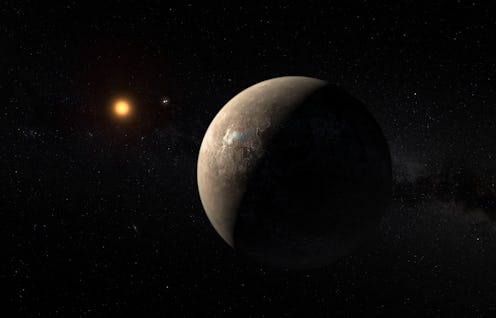If you've ever wondered about life outside of Earth, you will likely be curious to learn more about Proxima B, the Earth-sized exoplanet that first started making waves in August of this year. For example, how far away is Proxima B? Is it close enough that we could live on Proxima B? I mean, let's be honest: While learning about what exists in our universe is truly fascinating in and of itself, a lot of us may also be looking for escape routes from our current planet right now. It never hurts to have options, right?
According to Ashley Strickland at CNN, Proxima B is about 4.25 light years away from Earth. This breaks down into 5 trillion miles, or 40 trillion kilometers. To give you some scope on what that looks like, Jacob Aron at New Scientist explains that the distance between Proxima B and the Earth is 266,000 times the distance between the Earth and the sun, which are 92.96 million miles apart. For the curious, traveling at regular speeds, it would take thousands of years to reach Alpha Centauri, which, at 4.3 light years, is a similar distance away; if we could travel faster than the speed of light, though (which we can't right now), the trip could theoretically be accomplished in just a few days.
What makes Proxima B particularly interesting is that it, like the Earth, is also a "rocky planet" (in comparison to a gas planet, like Jupiter). In terms of size, Proxima B is 1.3 times larger the Earth. Proxima B even has its own star, which it orbits every 11 days. As Calla Cofeild explains at Space.com, researchers estimate that it could take 20 years for miniature probes to reach Proxima Centauri, which is the closest star to the sun, and what Proxima B orbits.
Of course, there are mixed opinions on whether we could ever live on this Earth-ish planet. As of right now, for example, we don't know if there is an hospitable atmosphere on Proxima B. Some studies also suggest that Proxima B would have intense radiation unlike what we experience on Earth; additionally, it's unknown how that radiation (if it exists) might impact life on Proxima B. Compared to what we experience on Earth, explains Strickland at CNN, Proxima B's radiation could be "ultraviolet and X-ray flares that are 100 times the intensity of what Earth receives from the sun."
As of right now, the jury remains out on whether or not we'll ever actually reach Proxima B, and beyond that, whether or not it is even habitable for humans. Still, every time we discover new planets, it's a huge step for science and our understanding of the universe. As scientists continue their research, they are literally opening up entire new worlds, and along with them, opening up future for humanity. We'll have to keep a close eye on Proxima B and what life conditions might be like on the new planet. Vacation time, anyone?
Images: Giphy (2)
